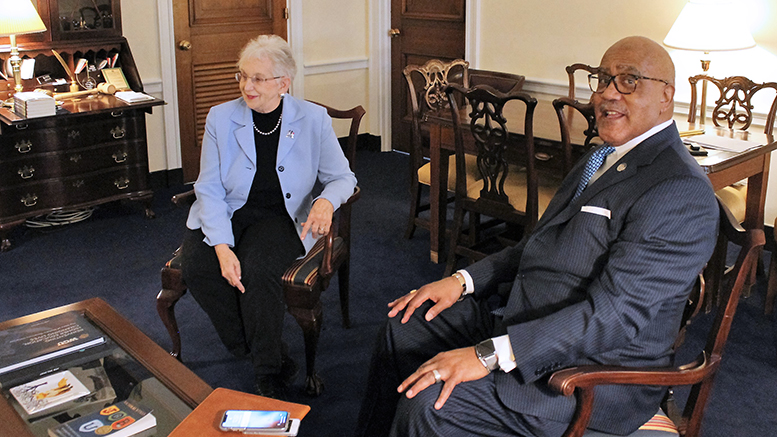The House Education and the Workforce Committee last month passed a bill that would significantly rework the nation’s main higher education law, but the committee chairwoman reminds stakeholders — especially community college advocates — that there are plenty of opportunities to change parts of the bill as it works through the legislative process.
In an interview Monday that included Walter G. Bumphus, president and CEO of the American Association of Community Colleges (AACC), Rep. Virginia Foxx (R-North Carolina) emphasized that the PROSPER Act — the House bill to reauthorize the Higher Education Act (HEA) — is not set in stone, and that she and the committee are open to hearing thoughts about the bill.
In the discussion, Bumphus highlighted parts of the bill that AACC supports, such as opening Pell Grant eligibility for certain short-term credential programs. He also noted parts of the bill that concern community colleges, such a language creating institutional risk-sharing and eliminating the Strengthening Institutions program (Title III-A).
Foxx noted that the members of her committee were very focused on the issue of improving student success and completion. That was the impetus for the risk-sharing language.
“In the past, it has not been taken seriously that students were not completing,” she said.
With regard to Title III-A, Foxx would like more statistics on the program, but the idea is to refocus funding for the program to have a larger impact on a broader range of students. But, she added, the legislative process is not completed.
“We are open to amendments, and we are open to continuing to listen,” she said.
Providing a higher education pathway
Foxx, who over her career has served as a community college president for nearly seven years, said the bill takes significant steps in reworking HEA. One of the biggest proposed changes is to open Pell Grant eligibility to students enrolled in short-term technical and career programs. She envisions certain short-term programs as the first step on a pathway to a baccalaureate and other higher degrees.
“When I was a community college president, I pushed over and over again for short-term certification within longer term programs,” she said. “What we see here [in the bill] is the ability for community colleges to recruit students into certificate programs, diploma programs and degree programs and start them out in some short-term programs that will lead into those longer programs.”
It will help both employees and employers, Foxx said, noting that there are currently six million unfilled jobs in the U.S. The full range of business and industry — from grocery stores and restaurants, to manufacturers and construction companies — need skilled workers, and they are willing to participate in a system that allows their employees to earn stackable credentials and opens a career path for them, she said.
“Community colleges are in the best position to help provide the skills that we need to fill those six million jobs,” Foxx said.
Bumphus agreed that two-year colleges can open those opportunities.
“It’s so important to get people in the front door and have them experience success, which for some is the first success in their lives. It’s game-changing,” he said.
Focused on completion
One criticism of all postsecondary education is low completion rates, Foxx said. That ties into high debt, especially among those who don’t complete a credential, she said.
Bumphus noted that the AACC 21st-Century Commission report’s priority recommendation is to increase graduation and completion rates by 50 percent by 2020.
“Presidents on this commission agreed that our graduation and completion rates were woefully inadequate. We needed to improve,” he said.
Since the report’s release in 2012, community colleges have been working toward those higher rates, with many college leaders confident that their institutions will meet that rate of completion.
“We will be significantly improved from when we started this,” he said. “Community colleges are laser-focused on completion in both policy and practice.”
Input from stakeholders
Foxx noted that the PROSPER Act was crafted with input from stakeholders. She recalled how not long after she came to Congress she spoke with a community college financial aid adviser who recommended that colleges have the leeway to give students advice not to borrow the maximum amount.
“She was the first person who alerted me to that,” Foxx said, and it stuck with her through the reauthorization process and was included into the bill.
The Congresswoman also noted other parts of the bill that serve to improve higher education, including language to strengthen reverse transfers, competency-based education, work study and ability-to-benefit. The bill also eliminates costly origination fees on student loans.
“It’s not just my legislation. This is being driven by the idea of a lot of people and their experiences,” she said.
Creative solutions
Bumphus and Foxx discussed the needs of employers, with Foxx noting that she met this week with representatives from the food marketing industry, who need truck drivers. Industry officials also conveyed to her that they want to offer employees a career pathway toward management jobs in the industry.
Many colleges are already working with business and industry to provide such opportunities, Bumphus said, citing as an example Arkansas State University-Newport’s partnership to serve local industries, including trucking and healthcare. (See the current issue of AACC’s Community College Journal.)
Foxx lauded such innovative efforts.
“It’s really up to the imagination of the community college president,” she said.

